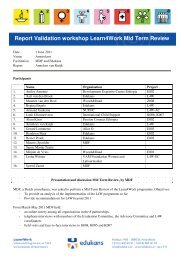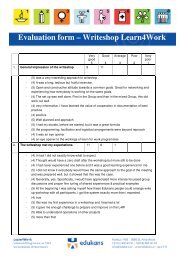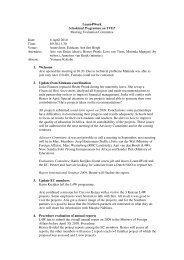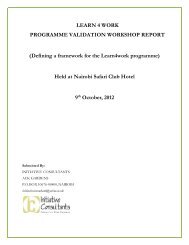Non â Formal TVET Mapping Survey Supported by Edukans ...
Non â Formal TVET Mapping Survey Supported by Edukans ...
Non â Formal TVET Mapping Survey Supported by Edukans ...
Create successful ePaper yourself
Turn your PDF publications into a flip-book with our unique Google optimized e-Paper software.
<strong>Non</strong> – <strong>Formal</strong> <strong>TVET</strong> <strong>Mapping</strong> <strong>Survey</strong> The case of Amhara, Oromia and Addis Ababa<br />
EXECUTIVE SUMMARY<br />
The purpose of the study was to conduct a mapping survey on <strong>Non</strong> <strong>Formal</strong> Technical and<br />
Vocational Education and Training (NF-<strong>TVET</strong>) with the objective of promoting the<br />
applicability of NF-<strong>TVET</strong> program for self-employment of the poorest of the poor, the<br />
last 10% to 20% of the population. The out put of the study can assist to categorize<br />
modalities of trainings given, profile of training providers and identifying indicators that<br />
enable to recruit target trainees.<br />
To this effect, the study employed a descriptive survey method for generating qualitative<br />
and quantitative data. Secondary data was also gathered. To generate required data, three<br />
types of data collection tools were developed and used. These instruments were:<br />
<br />
<br />
<br />
<br />
An interview guide was developed for collecting primary data from managers of<br />
training institutes, trainers and trainees.<br />
Focus group discussion guides for soliciting necessary data from trainees.<br />
Observation checklist<br />
Document analysis Issues were also identified and used.<br />
As part of the data collection process, the assistant researchers who were in charge of the<br />
data collection and write up of field reports were involved in the initial planning,<br />
enriching and refining of the data collection instruments. In the effort to build team spirit,<br />
the research assistants were briefed about NF-<strong>TVET</strong> and the major issues that could be<br />
addressed <strong>by</strong> the study. With this induction, the research team had to prepare the final<br />
research instruments. The data collection work took seven days in each of the two regions<br />
and the Addis Ababa city administration. The data brought <strong>by</strong> the three data collection<br />
groups was later analyzed and interpreted <strong>by</strong> the lead consultant involving the assistant<br />
researchers.<br />
Concurrently, related literature was reviewed from a variety of resources from national<br />
and international perspectives to promote learning and understanding of NF<strong>TVET</strong>. The<br />
information obtained was considered in writing the final report. Based on the information<br />
generated <strong>by</strong> the study the main findings and the recommendations are the following.<br />
Major Findings<br />
i<br />
ii<br />
<strong>Non</strong>- <strong>Formal</strong> <strong>TVET</strong> is provided in over 400 government, Private, community and<br />
non-governmental organizations. The number is expected to be much more than<br />
this as there is one FTC at Kebele peasant association.<br />
Ownership: There are NF-<strong>TVET</strong> centers/institutions that are owned <strong>by</strong> the<br />
government, NGOs private organizations and the community. The modality of<br />
delivery in some cases is institutional, community based, and apprenticeship. One<br />
of the training modalities was found also to be to be mobile.<br />
iii Objectives: The objectives of running NF<strong>TVET</strong> programs are different depending<br />
on the target groups. Most government and NGO institutions provide NF<strong>TVET</strong><br />
training to enable poor youths and adults become self-employed and earn their<br />
Education Expertise Center Feb 2008 1







